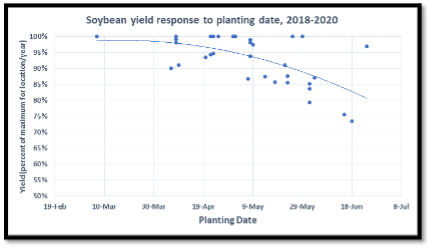ILSOYADVISOR POST
Risks and Rewards of Planting Soybean Early
Farming is a business that is built on supply, demand, biology, and the environment. It is the greater understanding of these factors that influence decisions and profitability of a given farming operation. In many situations, farmers must weigh the risks and rewards before a decision can be made. In recent years, more producers have been planting soybeans earlier and before their corn crop. A corn plant is much more sensitive to early planting stresses that can impact the seed viability, development of the root system, and the overall survival of the seedling plant. Because of its sensitivity to these stresses, more soybeans are being planted prior to corn.
There is a full list of ‘primary’ rewards associated with planting soybeans early, which typically includes improved yields and improved profits. These give rise to a host of ‘secondary’ rewards. In a strong corn on corn rotation, this is considered more of a monoculture cropping system and allowing for another crop to be grown instead of corn will have a positive impact on the field and its biology.
- Reduced tillage and compaction
- Different communication with soil microbial population
- Introduction of cover crops
- Introduction of different modes of action to fight against waterhemp
Over the last 10 years, several farmers, seed companies, and agronomists have conducted research to better understand the reward of planting early. In many situations, an 8 to 10 bushel advantage can be found from simply planting sooner than one would usually plant. Based on current future markets, a soybean producer could see an additional $100-$130 per acre by simply developing a plan and planting soybeans early. The below chart is from Bayer Crop Science.

Risks
- Added cost of replant from seedling disease
- Added cost of replant from frost damage
- Reduced stands and not being able to replant or spot-in
- Grain fill damage from SDS
Rewards
- Allows the unifoliate to start photosynthesis sooner, allowing the plant to start making its own food/energy sources
- Increased amount of sunlight a soybean crop can harvest in each season
- Development of more nodes and pods that a plant can strive to retain
- Root systems become more robust before entering summer stresses (heat and water)
- Allows for more foliage and develop canopy sooner
- Higher yield
- More profits
- More soybeans in a three- to five-year rotation (good for soil health and weed management/resistance)
SOY-ACTION:
1. Understand the risks associated with your fields and your regional geography.
2. Make sure soybeans are properly treated and protected.
3. Make sure to know what is considered “early” in your regional geography. Early may vary from northern to southern Illinois.
4. Make sure your seed suppliers know your early planting intentions, so your seed is ready when you are.





Comments
Add new comment